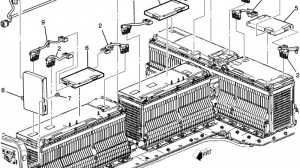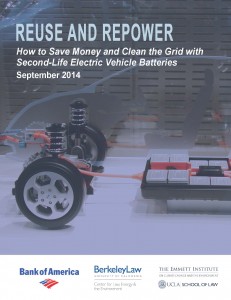 Used EV batteries — when they’re no longer able to store enough energy for driving but still have a lot of capacity left — seem like a great energy storage solution. After all, it’s cheap storage that could be used for all sorts of purposes, from backup power to bulk grid storage when multiple batteries are stacked.
Used EV batteries — when they’re no longer able to store enough energy for driving but still have a lot of capacity left — seem like a great energy storage solution. After all, it’s cheap storage that could be used for all sorts of purposes, from backup power to bulk grid storage when multiple batteries are stacked.
 I’m personally bullish on the opportunities and have blogged about all the investments going on in demonstration projects. I also authored a report for UC Berkeley and UCLA Law schools on the potential: Reuse and Repower: How to Save Money and Clean the Grid with Second-Life Electric Vehicle Batteries.
I’m personally bullish on the opportunities and have blogged about all the investments going on in demonstration projects. I also authored a report for UC Berkeley and UCLA Law schools on the potential: Reuse and Repower: How to Save Money and Clean the Grid with Second-Life Electric Vehicle Batteries.
But Charged EVs now reports on a new Lux Research study that thinks recycling will make more sense than repurposing:
In “Reuse or Recycle: The Billion-Dollar Battery Question,” Lux says that reusing batteries from EVs “will deliver questionable returns due to reduced performance, limiting them to applications with less frequent and shallower depth of discharge cycles.”
Lux forecasts that, in 2035, 65 GWh worth of used EV batteries will come on the market each year. An oversized 11.2 kWh residential storage system made from second-life batteries will cost about $4,600, compared with $6,000 for a new 7 kWh system. However, reduced round-trip efficiency and cycle life make a second-life system a poor fit for residential units and other daily cycling applications.
It’s an open question to some extent. But the bottom line is we really don’t know how the batteries will perform. They may maintain their diminished second-life capacity for a long time. Or they might be easily repaired to boost cycle life and durability.
Furthermore, we don’t know all the different uses for these batteries. Even if the batteries aren’t great for deep discharge and regular use, there could be many applications involving less usage, from backup power to bulk aggregations that put less strain on any one battery in the chain. Ultimately we’ll need to see how the market responds and innovates.
Studies like these will therefore be more meaningful once we get data on some of these ongoing demonstration projects. Otherwise, it’s premature to make an assessment either way.


